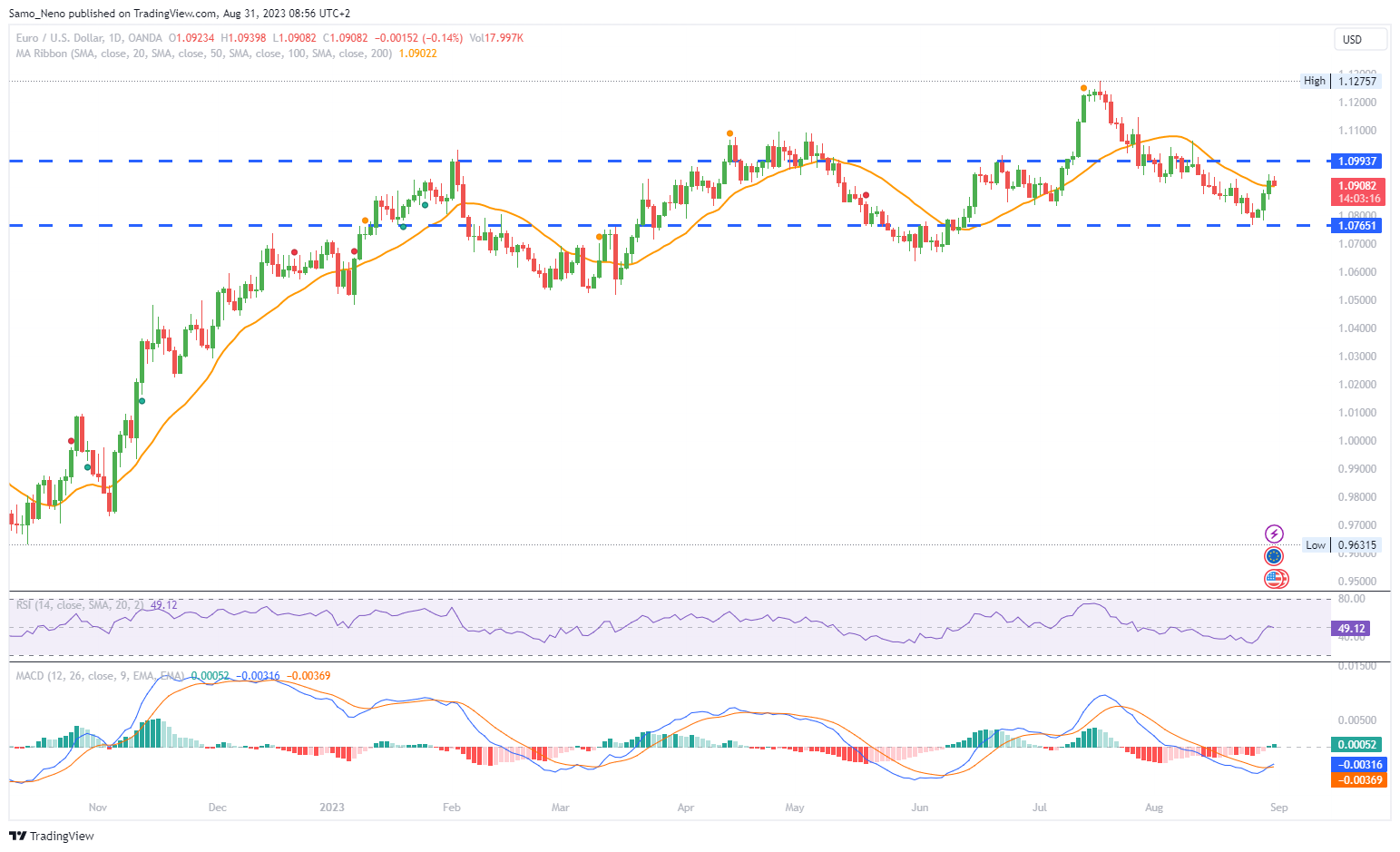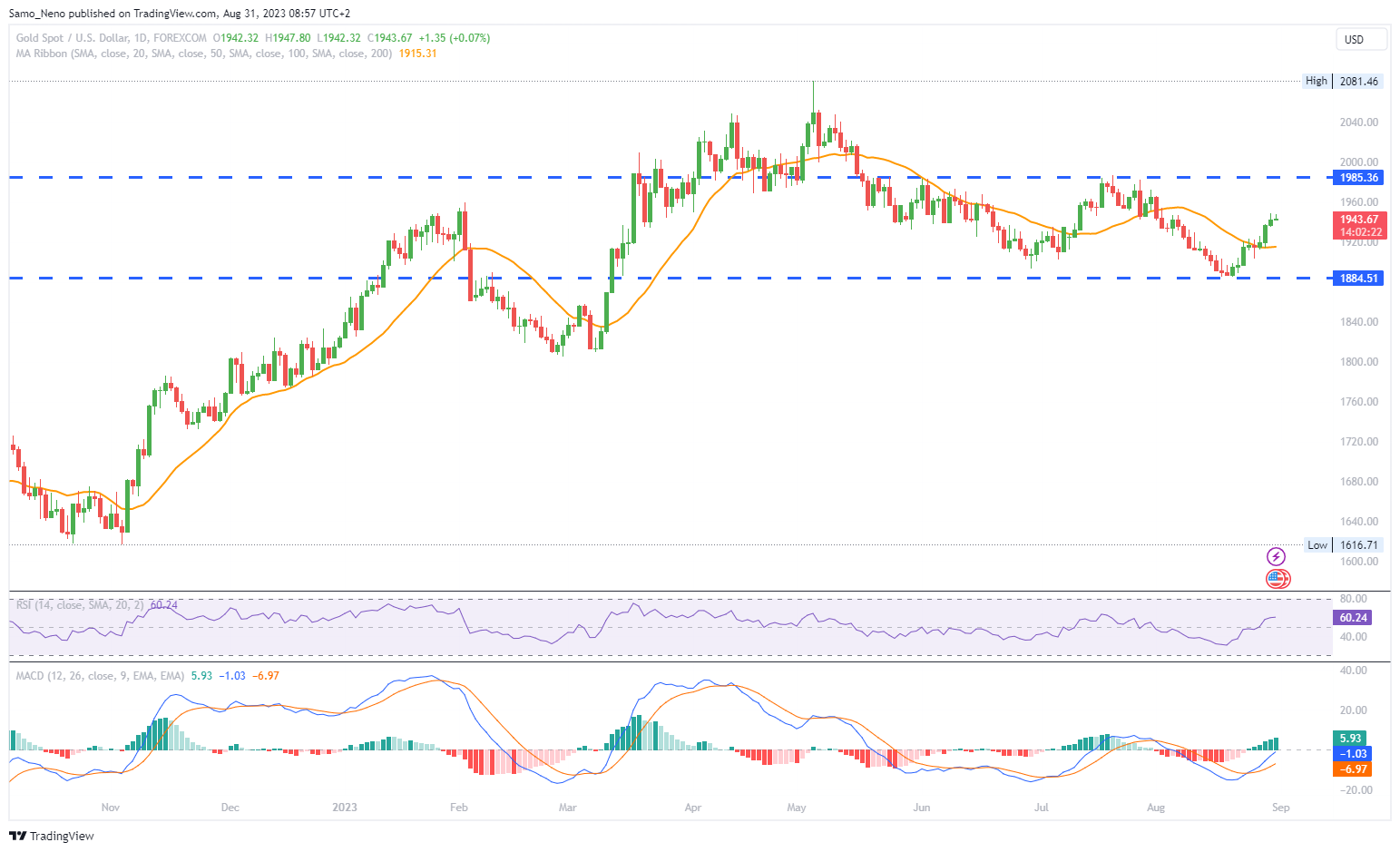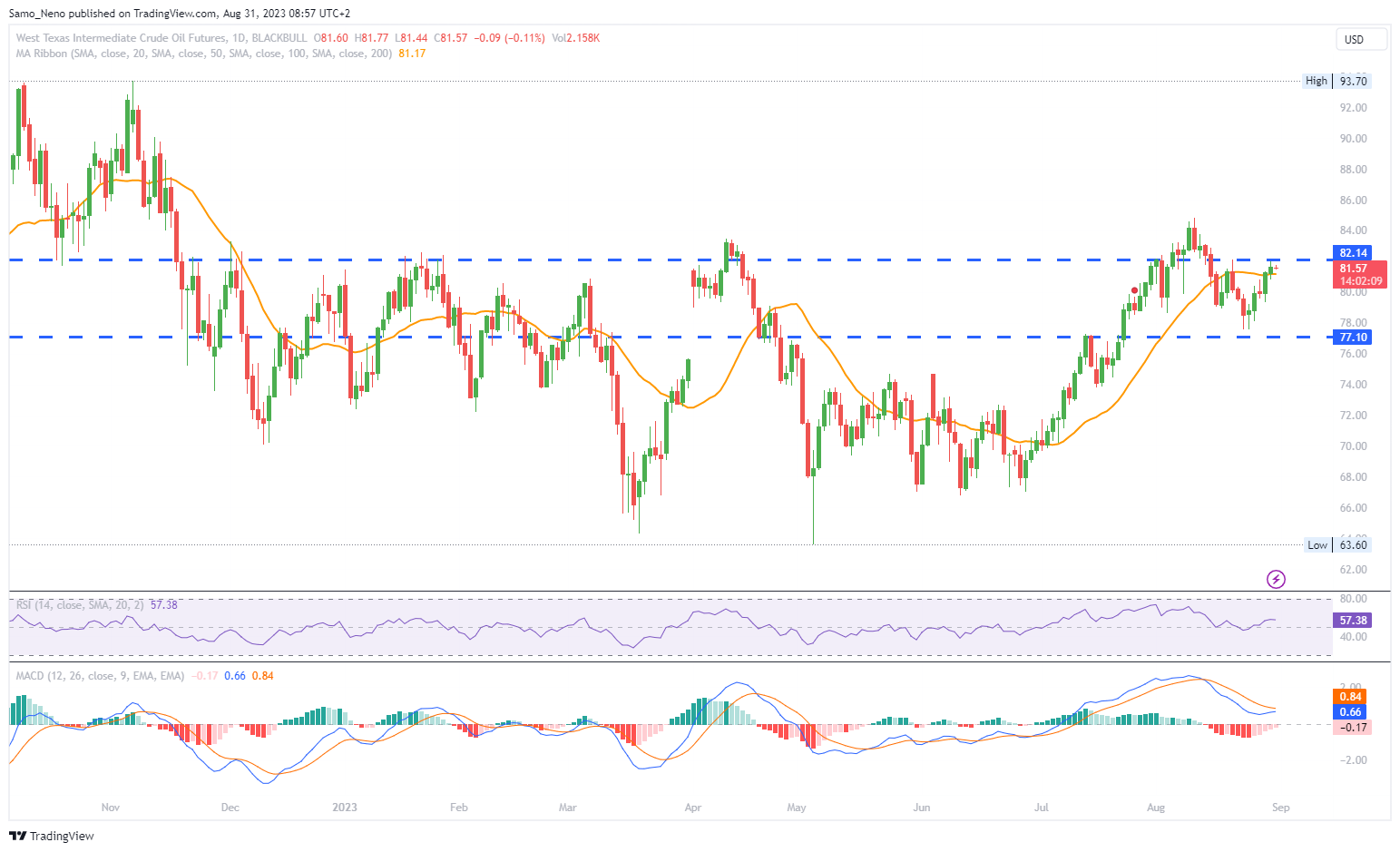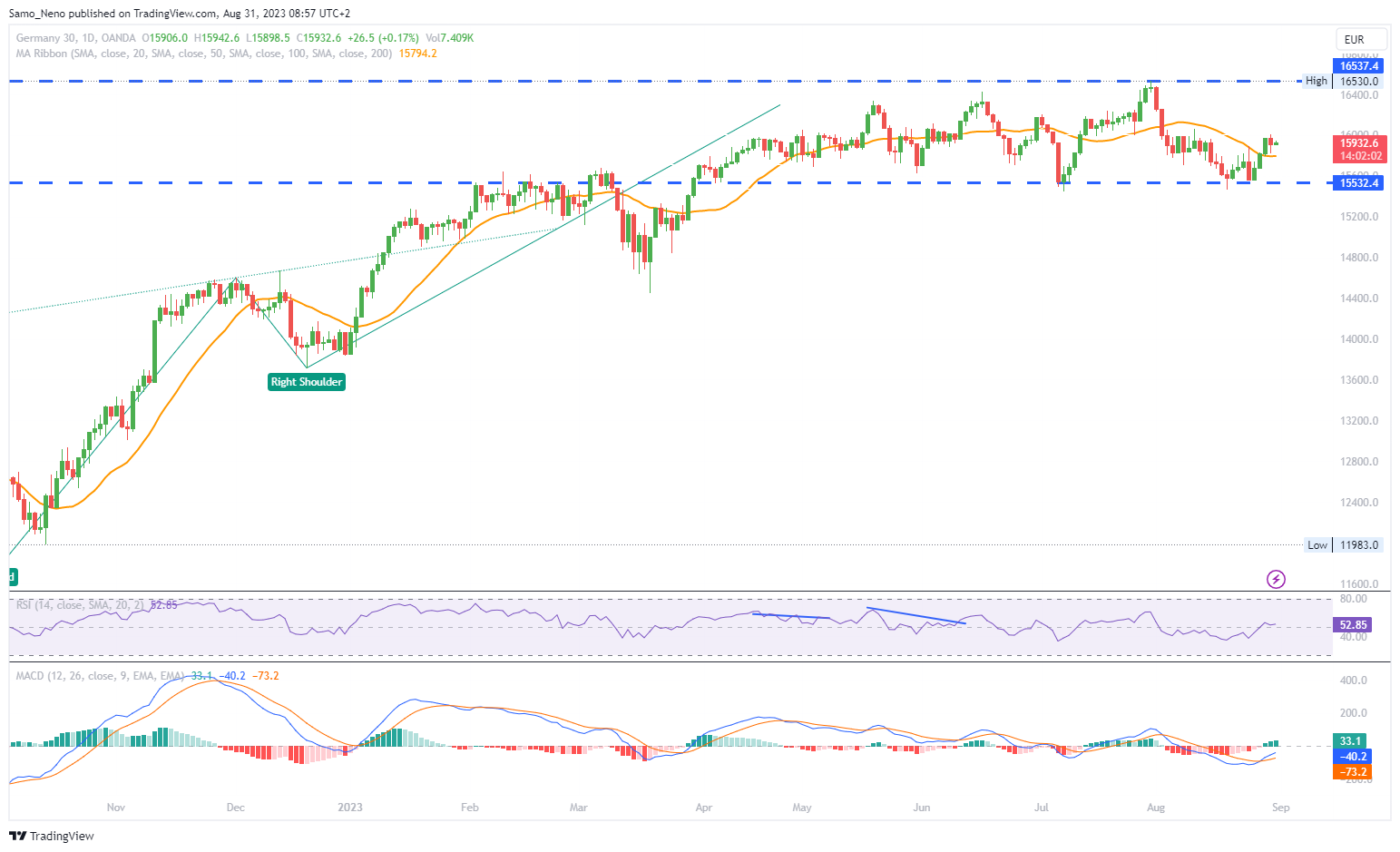EURUSD
- EUR/USD bulls are making a strong push, targeting the 100-day Moving Average (MA) at a two-week high. This move comes amid heightened anticipation for key inflation data releases from both the Eurozone and the US.
- Despite mixed economic data from the Eurozone, EUR/USD has rallied over the past three days, reaching around 1.0930 during the early hours of Thursday's Asian session. The rise can be attributed to weakness in the US Dollar.
- A decline in the US Dollar was triggered by softer economic data. The second readings of the US Q2 Gross Domestic Product (GDP) Annualized slipped from 2.4% to 2.1% compared to initial forecasts, along with a drop in the GDP Price Index to 2.0%. The ADP Employment Change also missed expectations, dropping to 177K from the forecasted 195K.
- Despite mixed German inflation indicators, the Euro remained resilient. This suggests that the market's focus might have shifted towards broader factors influencing the EUR/USD pair.
- The forthcoming Eurozone Harmonized Index of Consumer Prices (HICP) and Consumer Price Index (CPI) data releases are poised to impact EUR/USD trading. Furthermore, the US Core Personal Consumption Expenditures (PCE) Price Index for August, which is the Federal Reserve's preferred gauge of inflation, is also eagerly awaited.
Closing statement: The EUR/USD pair's recent movement has been driven by a combination of US Dollar weakness, mixed economic data, and market expectations surrounding inflation indicators. Both Eurozone and US inflation data releases are expected to be key factors shaping the direction of EUR/USD in the near term.
GBPUSD
- GBP/USD marked consecutive gains on Tuesday but struggled to maintain its bullish momentum as Wednesday began. The pair appears indecisive, likely influenced by upcoming economic data and broader market sentiments.
- Reassessment of the likelihood of a Federal Reserve interest rate hike is impacting the pair's movement. This came after the Job Openings and Labor Turnover Survey (JOLTS) report showed a decline in the number of job openings for the third consecutive month in July, reaching its lowest level since May 2021 at 8.8 million.
- The focus shifts towards US private sector employment data for August. The forecast suggests a rise of 195,000 jobs, following the significant increase of 324,000 jobs in July.
- If the reported employment figure falls within the range of 100,000 to 150,000, it could sway investor sentiment towards the belief that the Federal Reserve might not change its policy rate in 2023. This scenario could weaken the US Dollar.
- The near-term technical outlook for GBP/USD highlights its indecisiveness as traders remain on the sidelines, awaiting the US ADP Employment Change data for August.
| SMA (20) | Slightly Falling |
| |
| RSI (14) | Rising |
|
|
| MACD (12, 26, 9) | Slightly Rising |
|
Closing statement: GBP/USD's recent movements have been driven by the reassessment of the possibility of a US Fed rate hike, particularly due to the softer job openings data. The pair's near-term direction is expected to be influenced by the upcoming US private sector employment data, which could have implications for both the Pound and the Dollar.
GOLD
- Gold prices are edging closer to a significant technical level, the 100-Daily Moving Averages (DMA) situated around $1,955. This is accompanied by a persistent bullish sentiment in the market.
- Gold's rise is being fueled by ongoing weakness in the US Dollar. Despite the Dollar's decline against major counterparts, it remains under selling pressure due to soft economic indicators from the US.
- The US Dollar Index is hovering around two-week lows near 103.00. This downward trend in the Dollar is mirrored in US Treasury bond yields, which are also being affected by renewed dovish bets related to the Federal Reserve's future actions.
- Gold is recovering from losses suffered earlier in the month, supported by the continued bearish momentum in the US Dollar and Treasury bond yields. These factors are driving investors toward safe-haven assets like Gold.
- Gold's recent upward movement aligns with the prevailing weakness in the US Dollar. Traders are cautious ahead of key US economic data, including the US Personal Consumption Expenditures (PCE) inflation data scheduled for later in the day and the Nonfarm Payrolls release on Friday.
| SMA (20) | Slightly Falling |
|
||
| RSI (14) | Slightly Rising |
|
||
| MACD (12, 26, 9) | Rising |
|
|
Closing statement: Gold's climb towards the critical 100-DMA is driven by a combination of factors including the persistent weakness in the US Dollar, dovish Fed expectations, and ongoing economic uncertainties. These factors have enabled Gold to recover from its earlier losses, with market participants awaiting crucial US economic data to further gauge Gold's direction.
CRUDE OIL
- Crude oil prices experienced a decline on Thursday, partly driven by the release of disappointing manufacturing data from China. This data signaled a contraction in China's manufacturing activity for the fifth consecutive month, raising concerns about the country's economic expansion.
- The official purchasing managers' index (PMI) for China's manufacturing sector increased to 49.7 from 49.3 in July. However, it remained below the critical 50-point level, indicating a continuation of contraction in the sector.
- The US crude oil inventories also played a role in the oil price movement. The weekly measure of crude oil inventories, as reported by the Energy Information Administration (EIA), showed the largest draw in four weeks. This followed a similar trend reported by the American Petroleum Institute (API), which marked the biggest fall since September 2016.
- An additional factor impacting crude oil prices was the military coup in Gabon, an OPEC member. This event raised concerns about potential disruptions in crude oil supply.
- Market focus shifted to the US, where a report on personal consumption expenditure (PCE) was expected later in the day. This data was anticipated to influence market sentiment and potentially impact crude oil prices.
| SMA (20) | Slightly Falling |
| |
| RSI (14) | Slightly Rising |
|
|
| MACD (12, 26, 9) | Slightly Rising |
|
Closing statement: The decline in crude oil prices on Thursday was driven by multiple factors, including China's manufacturing contraction, the fluctuation in US crude oil inventories, geopolitical concerns in Gabon, and the forthcoming US PCE report. These dynamics created an atmosphere of uncertainty in the crude oil market, prompting investors to monitor data releases closely.
DAX
- The DAX, after a three-day winning streak, encountered a complex scenario as mixed economic signals and concerns of a looming recession in the Eurozone influenced investor sentiment.
- The release of Germany's Consumer Price Index (CPI) data brought attention to inflation trends. The monthly reading matched market expectations and previous figures, but the year-on-year (YoY) rate eased to 6.1% from 6.2%, slightly above the expected 6.0%.
- The Harmonized Index of Consumer Prices (HICP), which the European Central Bank (ECB) favors as an inflation measure, also displayed a similar pattern. MoM and YoY HICP figures decreased to 0.4% and 6.4%, respectively, compared to market estimates of 0.3% and 6.2%.
- ECB President Christine Lagarde's stance in the recent Jackson Hole speech was perceived as more hawkish than the US Federal Reserve (Fed) Chair Jerome Powell. While Powell emphasized data dependency, Lagarde suggested a more proactive approach towards higher rates.
- Given the mixed signals from economic indicators and the higher-than-expected inflation numbers, concerns about a potential recession in Germany and the broader Eurozone were raised. These circumstances increased the probability of an ECB rate hike in September, which could further impact market conditions.
| SMA (20) | Slightly Falling |
|
| RSI (14) | Slightly Rising |
|
| MACD (12, 26, 9) | Slightly Rising |
|
Closing statement: The DAX's recent performance, influenced by complex economic indicators and the possibility of a looming recession, indicates heightened uncertainty in the Eurozone. The interplay of these factors, along with the implications of potential ECB rate hikes, creates a challenging environment for investors.




